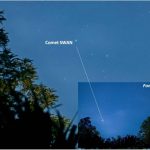

View at EarthSky Community Photos. | Dr Ski in Valencia, Philippines (latitude 9 degrees north), caught this image of the comet on May 2, 2020, and wrote, “Comet C/2020 F8 (SWAN) was discovered in March by NASA’s SOHO imaging. At magnitude +5, it was easy to spot through binoculars in nautical twilight when this image was captured.” Thank you, Dr Ski! Has the comet continued to brighten? Not as much as hoped so far, but you never know. Read on …
Earlier this spring, bright Comet ATLAS was brightening steadily, on a course that might have brought it into visibility with the unaided eye. That was before it broke our hearts by fracturing into multiple pieces. Then, surprisingly, a second comet – recently discovered and initially visible only from Earth’s Southern Hemisphere – began brightening and creating a buzz among those who watch the skies. Comet C/2020 F8 (SWAN) is now visible with good binoculars in Northern Hemisphere skies, too, although finding it requires skill, with only a small window for locating it each day. That’s because the comet is rising only shortly before the sun, and can be found near the horizon when dawn breaks.
This comet has already come closest to Earth (on May 12-13, 2020), at a distance of 51.7 million miles (83.2 million km).
It’s now heading toward its perihelion, or closest point to the sun, on May 27, 2020.
Amateur astronomer Michael Mattiazzo in Australia discovered comet C/2020 F8 (SWAN) on April 11, 2020. Mattiazzo was not looking at the sky when he made his discovery. Instead, he saw the possible – and then confirmed – comet while reviewing images captured by the Solar Wind ANisotropies (SWAN) instrument aboard the Solar and Heliospheric Observatory (SOHO) spacecraft overseen by NASA and the European Space Agency. This is Mattiazzo’s 8th comet discovery; like comet C/2020 F8 (SWAN), his others were found via inspection of SOHO images. It is the SWAN instrument’s 12th comet discovery. And it’s SOHO’s 3,932nd comet discovery!
Read more: Here’s how SOHO and a skywatcher discovered Comet SWAN
Comet C/2020 F8 (SWAN) was ejecting huge amounts of water vapor, which showed as hydrogen on SOHO’s instrument, according to the European Space Agency. Michael Combi from the University of Michigan estimated that, by April 15, the comet was ejecting about 2,866 pounds (1,300 kg) of water vapor every second.
Thus, during the month of April, Comet SWAN showed a trend of increasing brightness – likely due to that temporary outburst in activity – but then that trend stopped. As of early and mid May, the comet is not getting brighter, although it might (or not) get somewhat brighter in the days during which it’s approaching the sun for its May 27 perihelium.
That previous apparent outburst was enough to let experienced observers at southerly latitudes view the comet without optical aid, barely, using peripheral or averted vision.
Some experienced astrophotographers have been able to capture amazing long-exposure images of Comet SWAN, some of which show that the comet’s tail is extremely long, as long as 20 times the apparent diameter of the full moon! Those observers were lucky to image Comet SWAN when it was high in the sky from their perspective. As stated above, though, this comet appears low in the sky as viewed in Northern Hemisphere skies. Its nearness to the horizon might subtract a little brightness of this (already not-so-bright) celestial visitor.
Check out the tweets below:
Always brilliant images from Fritz Helmut Hemmerich, and no different this time. Comet Swan from the Canary Islands on the 10th. pic.twitter.com/UJZFrKG4Xy
— Con Stoitsis (@vivstoitsis) May 10, 2020
The excited wagging of Comet SWAN's ion tail. Photos by Gerald Rhemann, taken over the first 5 days in May. https://t.co/sCvcXsGIdf pic.twitter.com/bf8D3yRwa1
— Corey S. Powell (@coreyspowell) May 9, 2020
Visible to the unaided eye? Probably not, but with comets, you never know.
Of course, the question on everyone’s mind is, will Comet SWAN become visible to the unaided eye? And the answer is, probably not.
It’s important to note that the photographs above are made by experienced photographers using telescopes and other special equipment. They do not mean that Comet SWAN is or was clearly visible to the unaided eye for most observers.
Observers at latitudes like those in the southern U.S. (say, 30 degrees north latitude) and locations in both hemispheres close to the equator have the best chance – still only a slight chance – to view or capture this horizon-grazing comet. Your location on the globe will be key here. Also, sky conditions for observing Comet SWAN are quite challenging. Observers equipped with binoculars or a small telescope will have a small window – only a few minutes, just before dawn – to spot it. Seeing it will, of course, also require a clear sky and, in that sense, the ongoing Covid-19 pandemic appears to have provided many parts of Earth with clearer skies, especially toward your horizons, than usual.
If you have a camera capable of taking long-exposure photos (which provide far more sensitivity than the human eye), a good option would be to point the camera at the approximate area where the comet is located (even if you don’t see the comet; charts provided below), and take several images at different exposures (30, 45, 60 seconds, or more), as well as diverse zoom settings. Then review those images, as some may reveal the comet with its greenish color, and perhaps even a hint of its long tail.
And, of course – as usual with comets – the unpredictability factor has to weigh in. We just don’t know what comets will do, until they do it.
One thing is certain. Sky enthusiasts will continue to monitor the comet using binoculars, small telescopes and cameras. Just don’t be fooled by claims that Comet SWAN will provide an “amazing and spectacular show” to the unaided eye. If you do see the comet with binoculars or a small telescope, your view – at best – might be more like this:
Comet SWAN has gotten a bit higher for my location in southwest Alabama. So here it is through trees!
SWAN revealed some of the tail. Image Richard Pickard. pic.twitter.com/hUHcDWoPqF— Con Stoitsis (@vivstoitsis) May 13, 2020
You might catch it using binoculars or a small telescope, but with the caveat that it’s very, very close to the horizon, not to mention that it’s in our sky only shortly before dawn each day, as the comet approaches its closest point to the sun on May 27. Although any improvement in the comet’s visibility cannot be ruled out, it appears to be remaining just a binocular or camera target.
You’ll be looking toward your northeastern horizon, before sunup. See the charts at the bottom of this post.
Some charts to help you locate Comet SWAN in the sky
These charts are set for the latitude of the southern U.S. If you are elsewhere on the globe, the comet will be up at or around this same time of day, in front of these same constellations and near these same stars. But the comet, and the stars, will be oriented differently with respect to different horizons around the globe. Or they might not be above your horizon at all. Stellarium-Web is tracking Comet SWAN. Set your individual location on the globe, set the time for before dawn, face the program toward the northeast, and see the comet’s whereabouts each day.
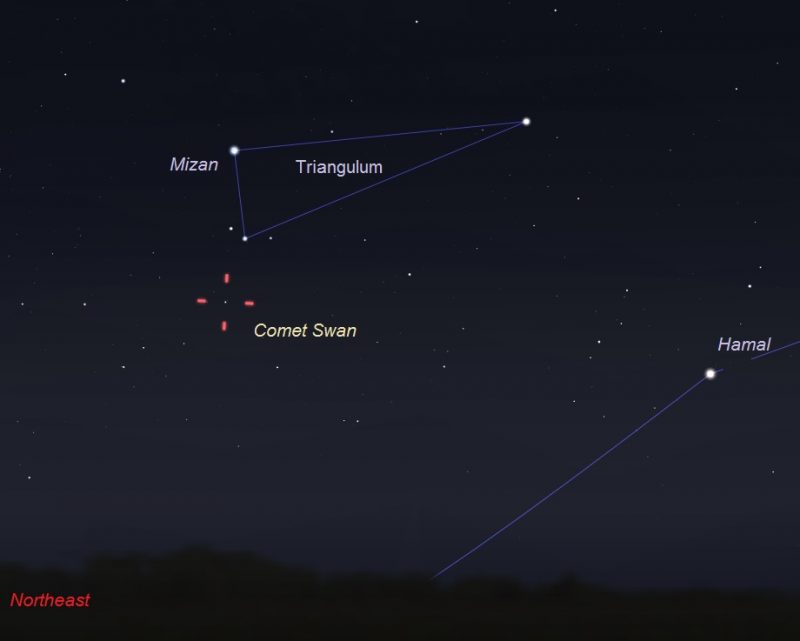
May 17, 2020, just before dawn. Facing northeast, as seen from southern U.S. For an individualized view, try Stellarium. Illustration by Eddie Irizarry using Stellarium.
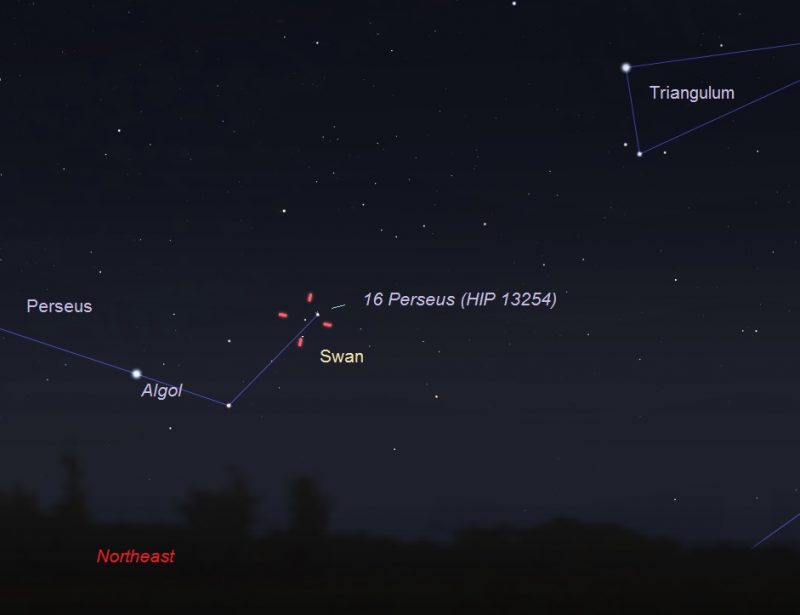
Location of Comet C/2020 F8 (SWAN) on May 19, 2020, shortly before dawn. Facing northeast, as seen from southern U.S. For an individualized view, try Stellarium. Illustration by Eddie Irizarry using Stellarium.
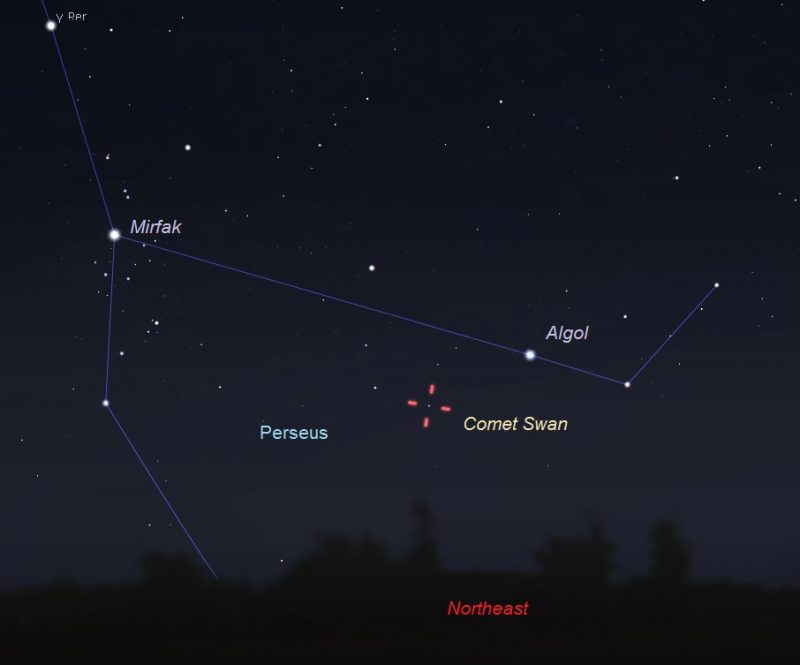
May 21, 2020, a few minutes before dawn. Facing northeast, as seen from southern U.S. For an individualized view, try Stellarium. Illustration by Eddie Irizarry using Stellarium.
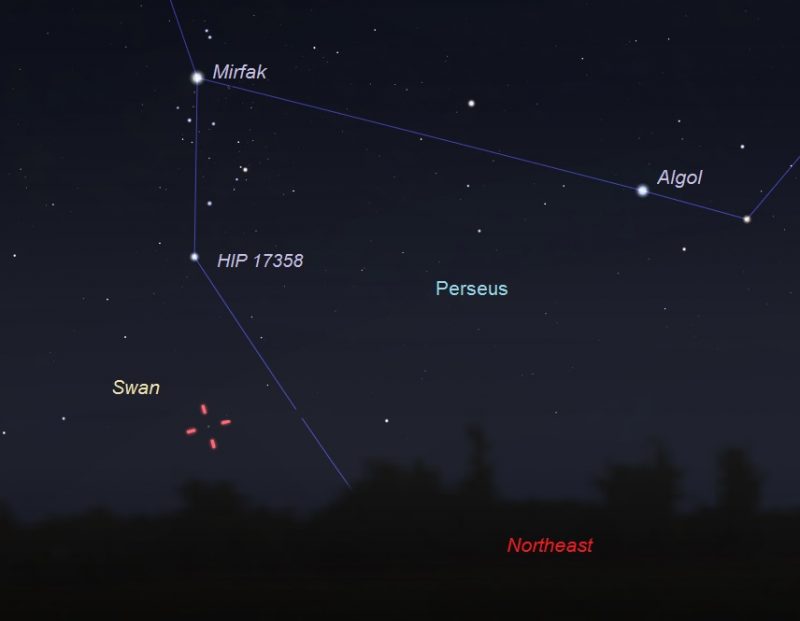
By May 24, 2020, Comet SWAN will become increasingly closer to the horizon, making observations even more difficult, perhaps allowing only long-exposure photography. This chart faces northeast just before dawn, as seen from southern U.S. For an individualized view, try Stellarium. Illustration by Eddie Irizarry using Stellarium.
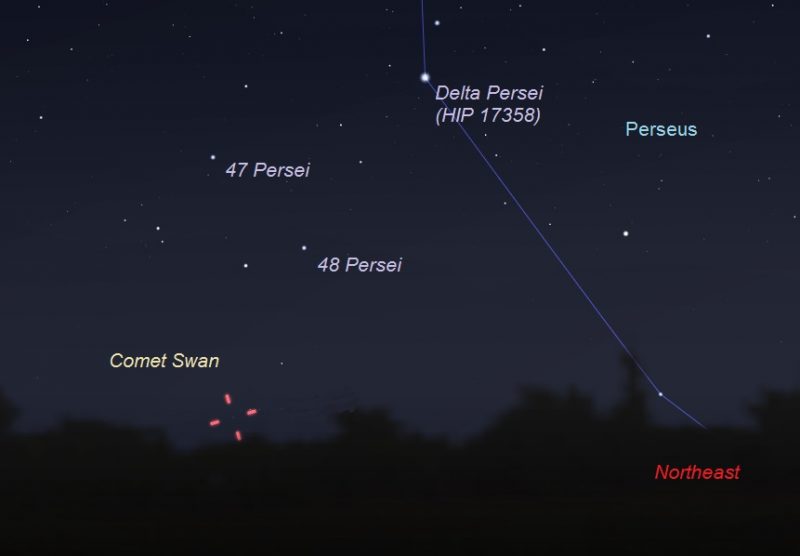
May 27, 2020. This is the date of the comet’s perihelion, or closest approach to the sun. At this point, Comet SWAN will be located extremely close to your sunrise horizon. This chart faces northeast just before dawn, as seen from southern U.S. For an individualized view, try Stellarium. Illustration by Eddie Irizarry using Stellarium.
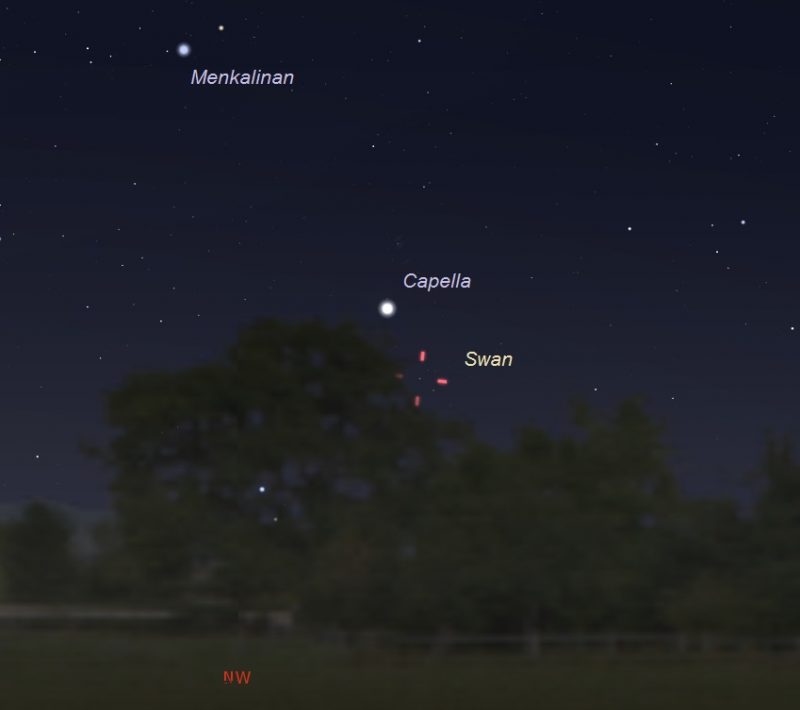
May 31 – June 1, 2020. After passing close to the sun, Comet SWAN will reappear early in the evening sky, and pass close to star Capella. This chart faces northwest during evening dusk, as seen from southern U.S. For an individualized view, try Stellarium. Illustration by Eddie Irizarry using Stellarium.
Bottom line: Comet C/2020 F8 (SWAN) has provided experienced astrophotographers with some amazing captures. Now, for Northern Hemisphere observers, it appears very close to the northeastern horizon before sunup; we don’t expect this comet to be widely seen, or to become easily visible to the eye. It likely won’t be a great comet visually, but amateur astronomers will be keeping an eye on Comet SWAN, just in case.
from EarthSky https://ift.tt/2TaXOIq


View at EarthSky Community Photos. | Dr Ski in Valencia, Philippines (latitude 9 degrees north), caught this image of the comet on May 2, 2020, and wrote, “Comet C/2020 F8 (SWAN) was discovered in March by NASA’s SOHO imaging. At magnitude +5, it was easy to spot through binoculars in nautical twilight when this image was captured.” Thank you, Dr Ski! Has the comet continued to brighten? Not as much as hoped so far, but you never know. Read on …
Earlier this spring, bright Comet ATLAS was brightening steadily, on a course that might have brought it into visibility with the unaided eye. That was before it broke our hearts by fracturing into multiple pieces. Then, surprisingly, a second comet – recently discovered and initially visible only from Earth’s Southern Hemisphere – began brightening and creating a buzz among those who watch the skies. Comet C/2020 F8 (SWAN) is now visible with good binoculars in Northern Hemisphere skies, too, although finding it requires skill, with only a small window for locating it each day. That’s because the comet is rising only shortly before the sun, and can be found near the horizon when dawn breaks.
This comet has already come closest to Earth (on May 12-13, 2020), at a distance of 51.7 million miles (83.2 million km).
It’s now heading toward its perihelion, or closest point to the sun, on May 27, 2020.
Amateur astronomer Michael Mattiazzo in Australia discovered comet C/2020 F8 (SWAN) on April 11, 2020. Mattiazzo was not looking at the sky when he made his discovery. Instead, he saw the possible – and then confirmed – comet while reviewing images captured by the Solar Wind ANisotropies (SWAN) instrument aboard the Solar and Heliospheric Observatory (SOHO) spacecraft overseen by NASA and the European Space Agency. This is Mattiazzo’s 8th comet discovery; like comet C/2020 F8 (SWAN), his others were found via inspection of SOHO images. It is the SWAN instrument’s 12th comet discovery. And it’s SOHO’s 3,932nd comet discovery!
Read more: Here’s how SOHO and a skywatcher discovered Comet SWAN
Comet C/2020 F8 (SWAN) was ejecting huge amounts of water vapor, which showed as hydrogen on SOHO’s instrument, according to the European Space Agency. Michael Combi from the University of Michigan estimated that, by April 15, the comet was ejecting about 2,866 pounds (1,300 kg) of water vapor every second.
Thus, during the month of April, Comet SWAN showed a trend of increasing brightness – likely due to that temporary outburst in activity – but then that trend stopped. As of early and mid May, the comet is not getting brighter, although it might (or not) get somewhat brighter in the days during which it’s approaching the sun for its May 27 perihelium.
That previous apparent outburst was enough to let experienced observers at southerly latitudes view the comet without optical aid, barely, using peripheral or averted vision.
Some experienced astrophotographers have been able to capture amazing long-exposure images of Comet SWAN, some of which show that the comet’s tail is extremely long, as long as 20 times the apparent diameter of the full moon! Those observers were lucky to image Comet SWAN when it was high in the sky from their perspective. As stated above, though, this comet appears low in the sky as viewed in Northern Hemisphere skies. Its nearness to the horizon might subtract a little brightness of this (already not-so-bright) celestial visitor.
Check out the tweets below:
Always brilliant images from Fritz Helmut Hemmerich, and no different this time. Comet Swan from the Canary Islands on the 10th. pic.twitter.com/UJZFrKG4Xy
— Con Stoitsis (@vivstoitsis) May 10, 2020
The excited wagging of Comet SWAN's ion tail. Photos by Gerald Rhemann, taken over the first 5 days in May. https://t.co/sCvcXsGIdf pic.twitter.com/bf8D3yRwa1
— Corey S. Powell (@coreyspowell) May 9, 2020
Visible to the unaided eye? Probably not, but with comets, you never know.
Of course, the question on everyone’s mind is, will Comet SWAN become visible to the unaided eye? And the answer is, probably not.
It’s important to note that the photographs above are made by experienced photographers using telescopes and other special equipment. They do not mean that Comet SWAN is or was clearly visible to the unaided eye for most observers.
Observers at latitudes like those in the southern U.S. (say, 30 degrees north latitude) and locations in both hemispheres close to the equator have the best chance – still only a slight chance – to view or capture this horizon-grazing comet. Your location on the globe will be key here. Also, sky conditions for observing Comet SWAN are quite challenging. Observers equipped with binoculars or a small telescope will have a small window – only a few minutes, just before dawn – to spot it. Seeing it will, of course, also require a clear sky and, in that sense, the ongoing Covid-19 pandemic appears to have provided many parts of Earth with clearer skies, especially toward your horizons, than usual.
If you have a camera capable of taking long-exposure photos (which provide far more sensitivity than the human eye), a good option would be to point the camera at the approximate area where the comet is located (even if you don’t see the comet; charts provided below), and take several images at different exposures (30, 45, 60 seconds, or more), as well as diverse zoom settings. Then review those images, as some may reveal the comet with its greenish color, and perhaps even a hint of its long tail.
And, of course – as usual with comets – the unpredictability factor has to weigh in. We just don’t know what comets will do, until they do it.
One thing is certain. Sky enthusiasts will continue to monitor the comet using binoculars, small telescopes and cameras. Just don’t be fooled by claims that Comet SWAN will provide an “amazing and spectacular show” to the unaided eye. If you do see the comet with binoculars or a small telescope, your view – at best – might be more like this:
Comet SWAN has gotten a bit higher for my location in southwest Alabama. So here it is through trees!
SWAN revealed some of the tail. Image Richard Pickard. pic.twitter.com/hUHcDWoPqF— Con Stoitsis (@vivstoitsis) May 13, 2020
You might catch it using binoculars or a small telescope, but with the caveat that it’s very, very close to the horizon, not to mention that it’s in our sky only shortly before dawn each day, as the comet approaches its closest point to the sun on May 27. Although any improvement in the comet’s visibility cannot be ruled out, it appears to be remaining just a binocular or camera target.
You’ll be looking toward your northeastern horizon, before sunup. See the charts at the bottom of this post.
Some charts to help you locate Comet SWAN in the sky
These charts are set for the latitude of the southern U.S. If you are elsewhere on the globe, the comet will be up at or around this same time of day, in front of these same constellations and near these same stars. But the comet, and the stars, will be oriented differently with respect to different horizons around the globe. Or they might not be above your horizon at all. Stellarium-Web is tracking Comet SWAN. Set your individual location on the globe, set the time for before dawn, face the program toward the northeast, and see the comet’s whereabouts each day.

May 17, 2020, just before dawn. Facing northeast, as seen from southern U.S. For an individualized view, try Stellarium. Illustration by Eddie Irizarry using Stellarium.

Location of Comet C/2020 F8 (SWAN) on May 19, 2020, shortly before dawn. Facing northeast, as seen from southern U.S. For an individualized view, try Stellarium. Illustration by Eddie Irizarry using Stellarium.

May 21, 2020, a few minutes before dawn. Facing northeast, as seen from southern U.S. For an individualized view, try Stellarium. Illustration by Eddie Irizarry using Stellarium.

By May 24, 2020, Comet SWAN will become increasingly closer to the horizon, making observations even more difficult, perhaps allowing only long-exposure photography. This chart faces northeast just before dawn, as seen from southern U.S. For an individualized view, try Stellarium. Illustration by Eddie Irizarry using Stellarium.

May 27, 2020. This is the date of the comet’s perihelion, or closest approach to the sun. At this point, Comet SWAN will be located extremely close to your sunrise horizon. This chart faces northeast just before dawn, as seen from southern U.S. For an individualized view, try Stellarium. Illustration by Eddie Irizarry using Stellarium.

May 31 – June 1, 2020. After passing close to the sun, Comet SWAN will reappear early in the evening sky, and pass close to star Capella. This chart faces northwest during evening dusk, as seen from southern U.S. For an individualized view, try Stellarium. Illustration by Eddie Irizarry using Stellarium.
Bottom line: Comet C/2020 F8 (SWAN) has provided experienced astrophotographers with some amazing captures. Now, for Northern Hemisphere observers, it appears very close to the northeastern horizon before sunup; we don’t expect this comet to be widely seen, or to become easily visible to the eye. It likely won’t be a great comet visually, but amateur astronomers will be keeping an eye on Comet SWAN, just in case.
from EarthSky https://ift.tt/2TaXOIq

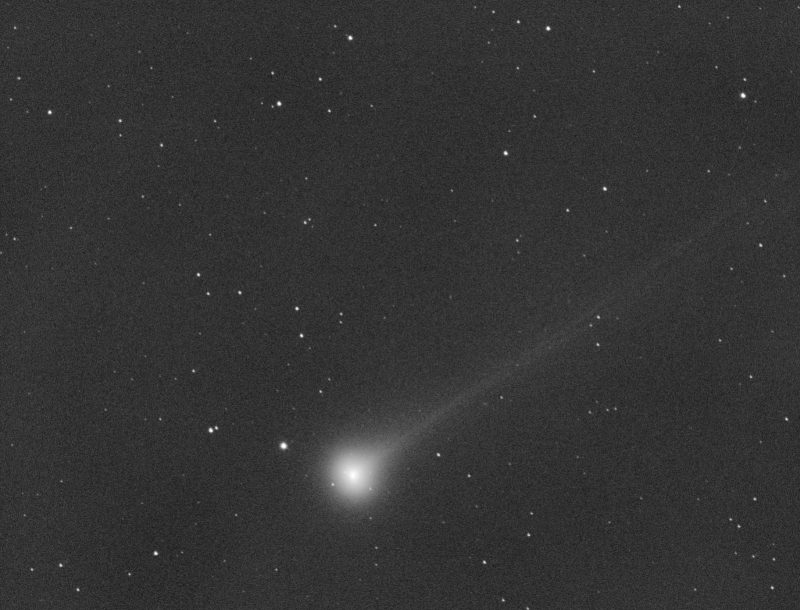
Aucun commentaire:
Enregistrer un commentaire